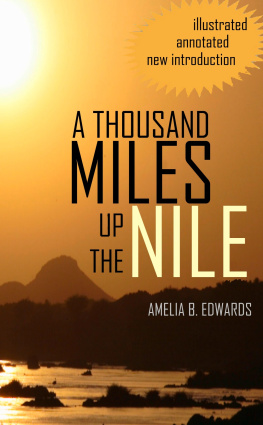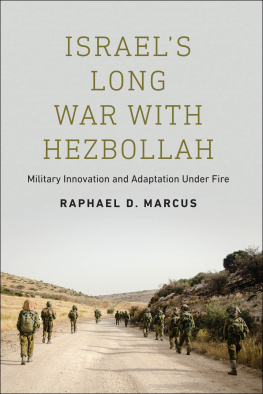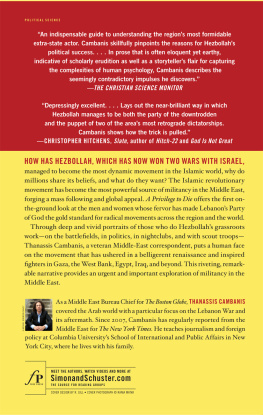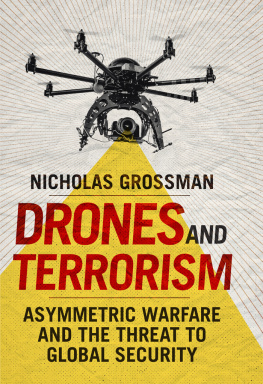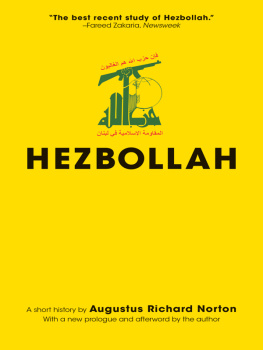Copyright 2011 by Nicholas Blanford
All rights reserved.
Published in the United States by Random House,
an imprint of The Random House Publishing Group,
a division of Random House, Inc., New York.
Random House and colophon are registered
trademarks of Random House, Inc.
Library of Congress Cataloging-in-Publication Data
Blanford, Nicholas.
Warriors of god: inside Hezbollahs thirty-year struggle against Israel /
By Nicholas Blanford.1st ed.
p. cm.
eISBN: 978-0-679-60516-4
1. ShiahLebanonHistory. 2. Hezbollah (Lebanon) 3. Lebanon
Military relationsIsrael. 4. IsraelMilitary relationsLebanon. I. Title.
DS80.55.S54B53 2011
956.92045dc22 2011012620
www.atrandom.com
Cover design: Carlos Beltran
v3.1
Contents
Introduction
AUGUST 4, 1994
CAMP SHAMROCK, Tibnine, south LebanonLike a stream of red ellipses, machine gun tracer rounds arched lazily across the inky night sky. Every few moments, a vivid white flash from an exploding artillery shell revealed for a microsecond the distant ridge line and the volcano-shaped silhouette of the outpost above Haddatha village, manned by Israeli-allied Lebanese militiamen and under attack by Hezbollah.
This was my first view of the fighting in south Lebanon and I was watching it with a cup of coffee alongside several Irish United Nations peacekeepers. The location of the Irish battalions headquarters granted it a clear southward view across a shallow stony valley to the ridge that marked the edge of Israels occupation zone.
To me, the battle unfolding a mile and a half away was a confusing kaleidoscope of colored lights and loud bangs. To the Irish officers, however, this was purely routine, an event they had witnessed many times. They sipped coffee, nonchalantly discussed where Hezbollahs mortars were probably located, and remarked on the improving accuracy of their bombardments.
This minor attackrecorded by the UN mission, known as UNIFIL, in one of many soon-forgotten shoot repscame during a period in which Hezbollah was gradually shedding its Lebanese civil-war image as a shadowy band of kidnappers and suicide bombers, and emerging in the public eye as a resourceful guerrilla army recording a growing number of battlefield successes against the Israeli occupiers of southern Lebanon.
Hezbollah had surfaced twelve years earlier, in the wake of Israels 1982 invasion of Lebanon. Few would have guessed at the time that this ragtag group of Shia militants, who drew guidance from Irans Ayatollah Ruhollah Khomeini and inspiration from the martyrdom of the sects founders fourteen centuries earlier, would survive the civil warlet alone become the dominant political and military force in Lebanon three decades later.
Indeed, it is extraordinary to contemplate that Lebanon, a country half the size of Connecticut, with no natural resources, fractious demographics, and an opaque sectarian political system, could give rise to an organization that has grown into the most powerful nonstate military group in the world.
In late 1996, when I began covering the conflict in south Lebanon for The Daily Star, Lebanons English-language newspaper, Hezbollahs post-civil-war military evolution was fully underway. Back then, however, its weapons and tactics were comparatively rudimentary and appropriate for its guerrilla-style methods. It was a conflict largely overlooked by the rest of the world, which had lost interest in Lebanon once the last Western hostages were released in the early 1990s. But it was a fascinating conflict to observe nonetheless. I soon learned to navigate the potholed lanes winding through the steep stony hills of the frontline district, and gradually built up a network of contacts on the ground. I studied military manuals, absorbing data on the weapons systems used by both sides, and scrounged ever more detailed maps of southern Lebanon, marking with a red pen the front line and the locations of outposts manned by Israeli troops and their South Lebanon Army militia allies.
There was an element of the routine about Hezbollahs deadly roadside bomb attacks and the daily mortar barrages of Israeli and SLA outposts. Sometimes I would sit on the flat roof of the restored Crusader fortress in Tibnine and watch the puffs of smoke from mortar shells blossoming against distant SLA compounds and hear the metallic crack of exploding Israeli artillery rounds. It was easy to be lulled into a false sense of security by these daily tit-for-tat exchanges. But the conflict also had the ability to quickly spiral out of control and then south Lebanon became a very dangerous place indeed.
By the late 1990s, it was evident that Hezbollah had all but won its campaign of resistance. The Israeli military simply could not dent Hezbollahs attacks, and the steady flow of troop casualties helped turn the Israeli public against the occupation. When Israel finally abandoned the occupation zone in three desperate days in May 2000, it was a truly historic momentthe first time the Jewish state had been forced to yield occupied land by the force of Arab arms.
It was around that time that I began to mull a book tracing Hezbollahs military evolution from 1982 to its successful culmination in Israels retreat from south Lebanon. Yet it soon transpired that that eighteen-year struggle was merely a precursor for what was to come next. The daily battles may have ended in May 2000 but the struggle continued, as Hezbollah in great secrecy morphed from an efficient guerrilla force using hit-and-run tactics into a crack infantry division capable of defending ground and defeating Israels top-line battle tanks. The scale of the transformation between 2000 and the outbreak of war in 2006 dwarfed the military advances of the previous decade. That evolution continued after the 2006 war, as Hezbollah and Israel absorbed the lessons of that conflict and prepared for the next one. Some of the military hardware at Hezbollahs disposal today would not look out of place in the arsenal of a medium-sized European state.
And yet, Hezbollahs massive military expansion has inevitably brought it into conflict with non-Shia fellow Lebanese, who fear the partys ideological and material ties to Iran and its determination to keep its weapons at all costs to pursue the confrontation with Israel. Hezbollahs struggle against Israel since 2000 has been matched by an internal tussle against its domestic critics. Lebanons complicated sectarian demographywith nineteen official sects squeezed into its cramped coastal cities, shadowed valleys, and soaring mountainsand recent history of communal strife has forced the Lebanese to embrace the gospel of consensus to maintain internal stability. Lebanon is a country that has been racked by civil conflict since long before the modern state was established in 1920. Although the Christian Maronites and the Muslim Sunnis and Shias are the three largest sects, none has sufficient weight to dominate all the others. As a result, Lebanons feuding communal leaders traditionally look to external backing to grant them influence over their domestic rivals. By the same token, foreign powers, both regional and international, are drawn into supporting Lebanese proxies to gain greater leverage against their own rivals in a geostrategically significant slice of real estate on the eastern Mediterranean. This symbiotic relationship between domestic client and foreign patron was evident as long ago as the mid-nineteenth century when the British backed the Druze, the French sponsored the Maronites, and the Sunnis were championed by the Ottomans. The same dynamic continues to endure today with the West, chiefly the United States, France, and Saudi Arabia, backing a mainly Sunni and Christian coalition while Iran and Syria support Hezbollah and its allies.




